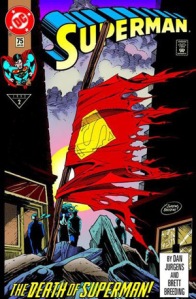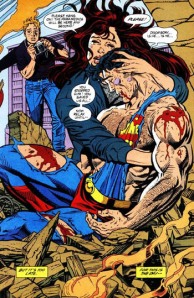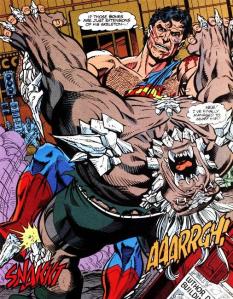john lawrence looks at one of the most iconic storylines in recent memory …
“The Death of Superman”
Superman: Man of Steel #18
Justice League of America #69
Superman #74
Adventures of Superman #497
Action Comics #684
Superman: Man of Steel #19
Superman #75
Every single comic collector on the planet that walks past a box of comics and sees a black polybag knows exactly what that issue is, and what’s inside.
In 1992, I was 15 years old and hadn’t read a comic book in years. I walked past a comic book store in Woodbridge Center mall and in the window display, there were huge figures of DC superheroes carrying a black coffin with a red Superman emblem. I walked into the store and asked what this was all about and the store employee informed me that it was for “The Death of Superman.” I asked him “ What the hell are you talking about? You can’t kill Superman!” He laughed, and then retrieved me a copy of Superman #75– and assured me that you most certainly can. I proceeded to buy the entire seven-issue story arc, and my love of comic books began anew. The writing and art of Dan Jurgens, Louise Simonson, Roger Stern, Jerry Ordway, and Karl Kesel worked together seamlessly across the titles and with each issue I became more anxious to know what would happen next.
At the very end of Man of Steel #18, we get a small cameo appearance tacked on to the end of an unrelated story, and we see a fist punching a steel wall with the caption “Doomsday is coming!”, and so our story begins. It continues with Doomsday single-handedly dismantling the entire Justice League America team (along with the shocking hands-on slaying of a deer and a swath of destruction across much of the United States) and finally culminates in the ultimate battle between Superman and Doomsday in Superman #75. Each issue reduced the panel count per page to increase a sense of epic storytelling as we got closer to the end, in Superman #75, each page of the comic is a single panel, delivered in exquisite detail. This brutal endgame was brought to life exquisitely by the art of Dan Jurgens.
The Death of Superman has always been a polarizing storyline amongst comic fans, ranging from people that absolutely hated the story, to fans like me that absolutely loved it. Whether you loved it or hated it, there’s no denying that this story changed the landscape of the DC universe forever and set in motion some of the greatest stories in comic book history. Without The Death of Superman, it’s hard to imagine DC going ahead with it’s almost-yearly line-wide crossover events; there would’ve been no Zero Hour, or Final Night, all the way down to the recent Blackest Night and Flashpoint. It also opened the doors for the death and replacement of major characters throughout the 90s and 00s; at one point or another, The Flash, Aquaman, Green Lantern, Green Arrow, Batman, Wonder Woman and perhaps a dozen more enjoyed a storyline where the titular character was injured or killed and replaced by a new recruit. None of this would have come to fruition without Superman’s death.
I was thrilled and honored to interview legendary comic book writer and artist Dan Jurgens, or as I like to call him, “The man who killed Superman,” and discuss one of the most controversial stories in comic history.
Pop-Break: There’s a number of versions of the story of how the Death of Superman story came about. In your words, how did this idea become reality, and what was your reaction when they said “Hey Dan, we’re going to kill Superman?”
Dan Jurgens: Of course, there were four [Superman] titles at the time, and the way we would work on them is we would gather someplace, usually New York. We would try and get all the writers and artists in a room along with editorial and kind of talk about various ideas. At this time, when I walked in, I had a yellow legal pad with two ideas written on it. One was a raging beast/monster fights Superman, and the other one was the death of Superman. We were in a conference room talking about various ideas and I never saw those two ideas as connecting.
The idea behind the raging beast was that at that time, Superman’s villains for the most part had been very cerebral type guys. Lex was basically just a businessman. Brainiac was certainly not a physical threat. It seemed like we were always up against this problem that Superman has all of these powers and we could do entire issues that he never got to showcase them. So, I wanted to do a knock-down, drag-out fight that wiped out half of Metropolis, and the death of Superman was something I had written down, because we had wind of talked about it before. It was a favorite story of mine growing up. There were the classic “imaginary” death of Superman stories that had been done in the sixties (Superman #149 – 1961).
So, we just started talking about various ideas, and that’s how these things all evolved. I think whenever you get fifteen to twenty people in a room, ideas get thrown out right and left and different people say different things, but it all coalesced into the Death of Superman and the beast became Doomsday.
PB: How did Doomsday’s name come about?
DJ: The name was something I never had. It’s kind of funny, because as we started to talk about the Death of Superman, we had charts on the wall, and Mike Carlin (editor of Superman books) just as a story title wrote “Doomsday for Superman.” So, as we were looking at it and starting to construct the story, I remember asking, “Is there a character name Doomsday?” We all started talking about it and at that point we decided to call him Doomsday.
PB: With four titles hinging on the story, how much creative leeway were you given with how the story was going to flesh out in the actual pages of your title?
DJ: The leeway comes when you’re in the room at that time and you start to plan out the story. As a creative team, we plotted out the story and said here’s what happens in Adventures, here’s what happens in Man of Steel, here’s what happens in Superman in Action, and that for example is where we came up with the idea of as we build to the story, the death of Superman issue will end all in splash pages. The issue before that will just be two panels per page. The issue before that, three panels per page, and the issue before that, four panels per page. We were sort of playing with time at that point, and by making each issue a “have-to-read,” you’re picking up speed in the story. So we planned all of that out. We certainly planned out the nuances of the story, the idea that we would first see Doomsday as a fist punching the steel wall of a vault without knowing that it’s deep underground, to build that tension. Then when you go back and write your individual issues, in terms of maneuvering around a little bit within the context of your own story, but still, by and large the main beats were planned out in those meetings.
PB: This was a huge story at the time. It was on the news, it was in the papers. It sparked some of the best-selling stories in the history of comics like Reign of the Supermen, Zero Hour (also by Dan Jurgens), and most recently Blackest Night. Do you ever just sit back and say “Wow, I was a part of this?”
DJ: I think I appreciate it more now than I did at that time. When you get further away from something like that and the industry changes, uou come to realize that it was incredibly unique, and there will never be anything like that again in comics.
PB: I heard there was some pretty serious backlash. How bad did it really get?
DJ: A lot of people really got very upset. I remember getting some very angry phone calls, and so was Mike Carlin as editor at DC. What we always tried to tell people was hang in there, we have a story to tell. Read the story, then when all is said and done with, if you don’t like it, then by all means register your complaints. Just hang in there and see what we’re doing here. As we planned out the story, the Death of Superman was interesting, but where it got more interesting for us as writers, was talking about a world without Superman. It was the idea the Ma and Pa Kent, as Clark’s parents, would be watching this all transpire on TV. In essence they are watching their son die, and couldn’t tell anybody, because the world didn’t know that Clark Kent was Superman.
It was also intriguing that once Superman was dead, everyone was going to be saying “Where is Clark?” We had President Clinton give a eulogy for Superman. We wanted to talk about the impact that Superman made on the world by removing him. I think we did that, and the cool part was, even as we were seeing these stories come out, these were the exact kinds of things that the columnists were writing. They were writing things like “what does this say about America, that we no longer have a Superman?” So we ended up with this really interesting duality between fiction and reality where you had writers of fiction, who were us, saying the exact same things that writers and columnists were saying in reality.
PB: Did you find it hard to pull double duty as the writer and the artist or do you feel that it helps you better convey your vision?
DJ: One of the questions I am asked all the time is “What do you like better: writing or drawing?” –and that sort of predisposes that I see it as two separate jobs. If I’m doing a comic book, I’m a story teller and it might say writer and artist, but if the credits allowed for it, it would just say by Dan Jurgens. I just don’t see it as two separate tasks. It’s all part of one job of telling stories. I think it helps because you are more able to realize your vision.
PB: Looking back, would you change anything about the Death of Superman story?
DJ: I really don’t think so. I really, really don’t. The way we formatted it was really so successful. The fact that it took place in three distinct chapters which were the Death of Superman, World Without a Superman, and The Return. We really didn’t know how we were going to bring Superman back until the books had hit the stands and it became this national deal, and we finally got together and said “when and how is he coming back”. I used to laugh because this was back in 92 and the internet was still in it’s infancy, but I would go on Compuserve and I’d see all these notes saying “I know how they’re going to bring him back, I’ve got an inside source.” I’d see stiff like that and laugh, because even we didn’t know how we were going to do it. I think what really drove home the success of the story was bringing him back in terms of four Supermen, and the mystery of which one was the real one. Of course, the answer was none of them. But, that added to the mystery and that added that sense of depth to the story, and by having those four Supermen, it allowed us to continue to build commentary on what is Superman. Of course, one ended up being a villain who destroyed Green Lantern’s city, which allowed them to do the Emerald Twilight stuff. Everything just went so well for that year with the Death of Superman, World Without Superman, or Funeral for a Friend, however you want to put it, and the Return of Superman, you know, I just really wouldn’t change anything.
PB: I really thought we were going to find out that it was the Eradicator, and that Superman just had a really big chip on his shoulder
DJ: I think if you go back to that time, that’s probably exactly what we wanted to be thought. It was probably 50/50 between people thinking it was the Eradicator and the Cyborg.
PB: I still hate the Cyborg. I’m such a Green Lantern fan that I have to be!
DJ: Before he did all of that though, it really could’ve been him.
PB: You’re currently on Firestorm. Can you share a little bit about what that’s like for you and what direction you’re heading with it?
DJ: I think Firestorm is one of those books that fits me really well. I’ve always liked characters that fly and have great powers where you can have some sense of spectacle. Firestorm fits that for me and in a way and I think Firestorm was very well conceptualized by Gerry Conway and Al Milgrom back in the 70’s. He quite a character. He’s a young kid with some similarities, in terms of attitude, with Spider-Man. I’m just having a great deal of fun with it.
PB: Anything else in the works besides Firestorm [which was recently discontinued by DC Comics] that we can look forward to?
DJ: For right now, writing and drawing a title is pretty much a full time gig, so that’s it for right now
PB: You have a unique style. Who would you say contributed to it? Who do you look up to?
DJ: Well I think with artists, it’s easier. Certainly guys like Neal Adams, John Buscema, Jack Kirby, who are really the classic kings, if you will. With writers, it’s a little bit different, for me at least, because I think sometimes the lessons you learn in terms of what not to do are more valuable than the lessons of what you learn to do. So, sometimes you’re learning from other people’s mistakes.
PB: My daughter really likes to help with everything I do and she wanted me to ask you two questions. First, she wants to know if you could’ve created any comic character besides your own, who would it be and why?
DJ: Wow, I’ve actually never been asked that question (laughs). I would have to say Superman or Spider-Man, but I would probably go with Superman because I think he best represents the ideals of what a hero should be. I’ve always thought that in a way, if you look at Superman’s origins, being from another planet, but being raised very much as a human, that there is a point that he is supposed to represent the very best in all of us.
PB: And for my daughter’s second question, if you could have any super power, what would it be?
DJ: I would probably say flight, but I bounce back and forth between that and invisibility. I think it would be great to turn invisible and go out and walk around. You know, you could turn invisible at a major league baseball game and go down to the dugout and say “ok what do you guys really talk about down here?”











Comments are closed.